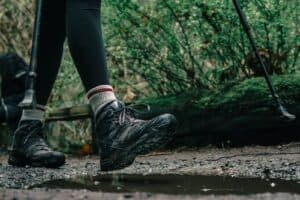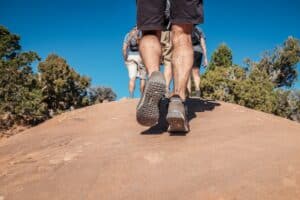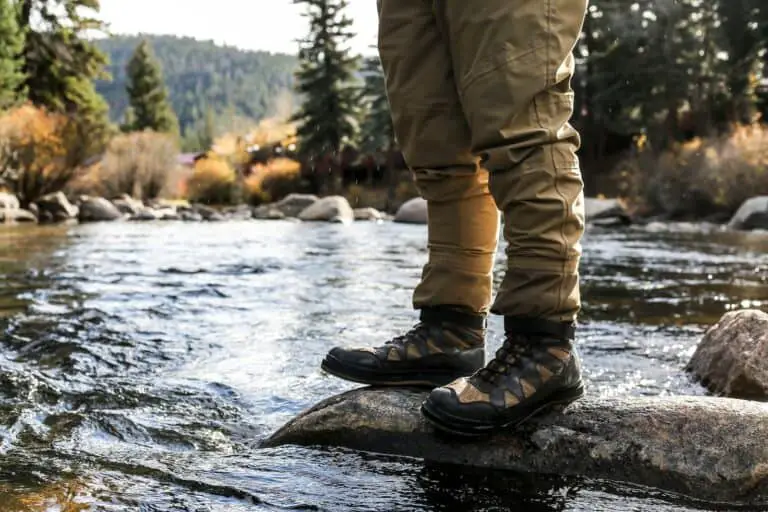When it comes to hitting the trails, what’s on your feet can make or break your experience. It’s the age-old debate: hiking boots or hiking shoes? Is it better to have hiking boots or shoes? Which one’s better? Well, I’m here to shed some light on this topic.
In this article, we’ll dive deep into the pros and cons of both hiking boots and hiking shoes. We’ll discuss factors like comfort, durability, and traction, among others. By the end, you’ll be equipped with the knowledge to make an informed decision for your next outdoor adventure.
Comfort: Boots vs Shoes

When it comes to the great boot versus shoe debate, we can’t skirt around comfort. It’s a key factor for any hiker hitting the trails. Does one offer more comfort than the other? Let’s delve into that.
Hiking boots boast excellent ankle support. When navigating uneven terrain, the high collar of a hiking boot provides stability preventing potential ankle injuries. The sturdy design, while might feel more restrictive, ensures your feet remain comfortable every step of the journey.
On the flip side, hiking shoes are lauded for their lightness and flexibility. With less weight on your feet, shoes allow for speedier travel across terrain. Unlike boots, shoes don’t require much ‘breaking in’. You can wear them straight out of the box without the worry of blisters or discomfort. A key argument in favor of shoes is their versatile nature. You can use them for other outdoor activities, hence getting more mileage from them.
However, let’s be clear – comfort is tremendously subjective. What feels as soft as a cloud to me might be uncomfortably squishy to another hiker. It’s best to consider other personal factors such as:
- Nature of hikes: Steep, challenging trails might demand the protection boots offer
- Hiking experience: A newbie might feel more at ease in a sturdy pair of boots
- Personal preference: Some simply find shoes comfier than boots and vice versa
Now that we’ve covered comfort, we can move on to discussing durability, another defining factor in the boots versus shoes discussion.
Durability: Boots vs Shoes
durability is a crucial factor to consider when choosing between hiking boots and shoes. With the rigors of hiking in mind, I’ll delve into which footwear proves to be the most durable.
Hiking boots are perhaps the more traditional option. Made typically from leather or some high-tech composite materials, they’re intrusive in design yet offer long-lasting usage. They are often well-crafted to survive different harsh conditions, making them a favorite amongst many seasoned hikers.
I’ve found that the soles of hiking boots typically endure longer than hiking shoes. The tougher and thicker materials of boots are less likely to wear down quickly. Now, that doesn’t mean they’re invincible. Over time, your boots will surely show signs of wear and tear—especially if you’re a frequent hiker. But, given their robust construction, hiking boots come out on top in terms of durability.
However, this isn’t to discredit hiking shoes completely. In fact, there’s a lot to appreciate about their longevity. These shoes usually have a more breathable design crafted with lighter materials. This means they are somewhat at a disadvantage in terms of durability compared to their boot counterparts. Yet, they are perfectly capable of lasting a good number of hikes—especially if you stick to well-maintained trails.
In essence, if you’re choosing based on durability alone, my money is on hiking boots. But, remember that the lifespan of your footwear largely depends on the care and maintenance you put in. Proper cleaning and storing of your boots or shoes will undoubtedly prolong their existence.
The next factor to sift through in the debate of hiking boots versus shoes is traction.
Traction: Boots vs Shoes

Just as durability, there’s much to consider when we talk about traction. Traction is vital for hikers, as it can make the difference between a safe trip and a dangerous fall. But which one provides better grip, hiking boots or hiking shoes?
Well, that largely depends on the types of surface you’re planning to hike on. Boots, being heavier and often equipped with deeper treads, can offer better traction on rough, wet, and slippery surfaces. Plus, their high-ankle design offers added stability on uneven terrains. That’s why boots can be a favored choice for long-distance hikers trekking through varied and changing terrains.
But let’s not undermine shoes. With lower cut design, they are lighter, offering better agility and mobility, which can be essential for dealing with obstacles on trails, such as rocks and roots. While their treads might not be as deep, these are perfectly suitable for well-groomed and maintained trails. Moreover, many hiking shoes now come with advanced, sticky rubber soles to improve traction on dry and rocky terrains. So, for day hikes on less technical trails, shoes can work perfectly fine.
Of course, traction also depends on other factors. These include your personal hiking style and gait, the weight of your backpack, and your comfort level with the footwear. My advice? Don’t compromise on the fit and comfort, no matter whether you’re selecting a boot or a shoe. A precise, comfortable fit not only reduces the chance of blisters but also improves traction.
To round it up, both hiking boots and shoes have their strengths in terms of traction. Which one to prefer will depend on your hiking requirements and personal preferences. Here’s hoping that this insight helps you to make an informed choice when buying your next hiking footwear.
In the next section, I’ll explore another important facet to consider, the weight. It’ll further establish whether boots or shoes are the right choice for your hiking needs.
Support: Boots vs Shoes
Moving forward from traction, another essential aspect that differentiates hiking boots from shoes is the level of support they offer. Let’s dive deeper into this.
On one hand, traditional hiking boots offer superior ankle protection and overall foot support. This is mainly due to their higher cut design, which extends past the ankle, and their sturdy construction. Offering more support to your feet, especially ankles, hiking boots can be a boon when you’re taking on tough, uneven terrains. Also, boots are generally more structured than shoes, reducing the risk of injuries when carrying heavy backpacks on long treks.
On the other hand, hiking shoes might appear to fall short when it comes to supporting your ankles due to their lower cut design. However, they come with their own set of advantages. Hiking shoes are cut low at the ankle, providing the wearer with more freedom of movement. Over tiered and challenging landscapes, this can translate into better agility and balance. And let’s not forget the lightweight factor here – hiking shoes, being lighter, minimize leg fatigue, making you less prone to twisting an ankle or other foot-related injuries.
- Remember:
In the end, it’s vital to consider the type of hiking you plan on doing. Choose wisely between boots and shoes based on your specific needs and the conditions of the trail. After support, let’s move onto another deciding factor in your choice of hiking footwear – comfort.
Versatility: Boots vs Shoes

Consider the versatility of your footwear when deciding between boots and shoes for hiking. It’s another principal factor shaping your decision. Hiking boots offer versatility through terrain adaptation, while hiking shoes provide versatility via performance and speed.
Boots, no doubts, win the race when it comes to tackling all types of terrains. Their sturdy built and high-ankle design ensures superior support and protection, even on the most rugged trails. Whether you’re venturing high up a mountain or navigating a rocky path, boots make your expedition more secure.
On the other hand, hiking shoes prove to be versatile in their kind of ways. The low-cut design not only enhances the freedom of foot movement but also improves the speed and agility of the hiker. They ensure optimal performance on well-maintained trails and enable a faster pace. But the crucial thing to remember is that, while they’re adept at dealing with flat landscapes, they might not provide enough support for challenging hikes.
It’s also smart to think about the weight of your footwear. Boots, due to their heavy-duty construction, usually outweigh shoes. If you’re a long-distance hiker or backpacker, this weight could significantly impact your ability and performance. Wearing lighter footwear, such as hiking shoes, can help maintain energy and offer a seamless hiking experience. However, the trade-off is less protection and support.
So, the decision regarding the best option – boots or shoes – banks upon your particular needs and the nature of the hike. Bear in mind; no one type of footwear will outperform the other in all areas. Both have their strengths that make them the right selection in their right instances.
Consider all the information before making your choice. Every hike is distinct, and thus, merit a tailored approach with your footwear selection. The upcoming part of the discussion will focus on the durability of boots and shoes, another critical aspect to chew over when selecting your hiking footwear.
Conclusion: Is it Better to Have Hiking Boots or Shoes
So, which is the better choice: hiking boots or shoes? It’s not as cut-and-dried as you might think. Boots offer terrain versatility, providing robust support and protection for any type of hike. They’re your go-to for rough and challenging trails. But don’t discount shoes just yet. They shine in terms of performance versatility, allowing for quicker movement on well-kept paths.
The real question at hand isn’t necessarily about boots versus shoes. Instead, it’s about understanding your specific hiking needs. Will you be tackling rocky terrains or sticking to well-maintained trails? Your answer will guide your choice.
The next part of our discussion will delve into the durability aspect of both boots and shoes. Stay tuned to find out which one outlasts the other. Remember, it’s not just about the right gear, it’s about the right gear for you.


